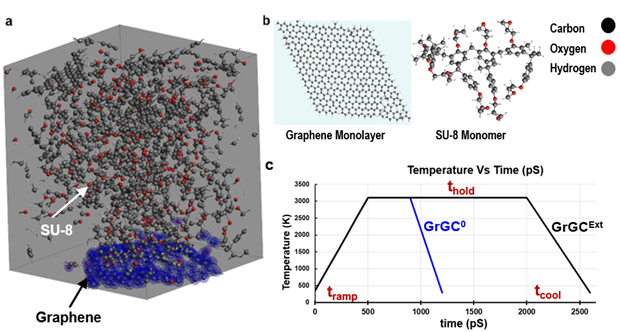Fundamental Insights in Novel Graphene-Glassy Carbon Hybrid Materials with ReaxFF
Using graphene (Gr) and glassy carbon (GC) as building blocks, recently a hybrid material with superior electrical and electrochemical properties was introduced. 2D monolayer graphene is considered as the gold-standard for electrical conductivity with its high charge carrier mobilities, high double-layer capacitance, and large surface area. On the other hand, GC is generally accepted as the gold-standard for electrochemistry due to its exceptional chemical inertness, high mechanical stiffness (in all planes), good electrical properties, high electrochemically stability (> 3.5 billion pulses at 0.25 mC/cm2), remarkably high charge storage capacity (61.5 mC/cm2), and fast surface electrokinetics coupled with lithography patternability. However, Gr’s monolayer thickness and, hence, its lack of 3-dimensionality introduces a critical weakness in its overall 3D mechanical strength, specifically in the transverse direction. Also, its imperviousness to molecules leaves much to desire in its charge storage capacity.
Then, could the unique strengths of these two carbon allotropes be further leveraged for introducing a new hybrid material that incorporates their best qualities? To answer this fundamental question and gain a fundamental understanding of (a) the process of evolution of this hybrid material, (b) its true 3D molecular structure, and (c) the type and distribution of active functional groups in this hybrid material, we used ReaxFF’s classical molecular dynamics modeling capability. Together with an experimental synthesis process and comprehensive morphological and surface material characterizations, the molecular dynamics modeling of the synthesis process demonstrated a validation and viability of the versatile hybrid material. This work in the use of ReaxFF for the exploration of discovery of hybrid materials, particularly from allotropes of carbon in high-temperature environment as reported here, opens up new research possibilities in experimental and modeling approaches that contribute to bridging the current gap that exists in isolated research in each of the carbon allotropes.

S. Nimbalkar, R. Montgomery-Walsh, J. Bunnell, S. L. Galindo, B. K. Cariappa, A. Gautam, R. Arvizu, S. Yang, S. Kassegne, Carbon allotropes form a hybrid material: Synthesis, characterization, and molecular dynamics simulation of novel graphene-glassy carbon hybrid material, Carbon, in press 2022
Key conceptsmaterials science organic electronics polymers ReaxFF